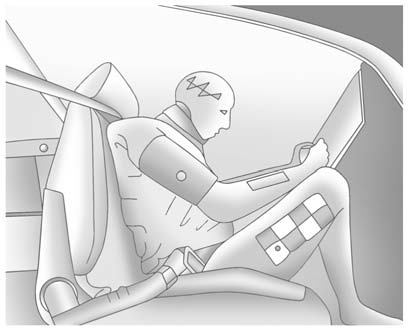Safety Belts
This section of the manual describes how to use safety belts properly. It also describes some things not to do with safety belts.
WARNING
Do not let anyone ride where a safety belt cannot be worn properly. In a crash,
if you or your passenger(s) are not wearing safety belts, injuries can be much
worse than if you are wearing safety belts. You can be seriously injured or
killed by hitting things inside the vehicle harder or by being ejected from the
vehicle.
In addition, anyone who is not buckled up can strike other passengers in the
vehicle.
It is extremely dangerous to ride in a cargo area, inside or outside of a
vehicle. In a collision, passengers riding in these areas are more likely to be
seriously injured or killed. Do not allow passengers to ride in any area of the
vehicle that is not equipped with seats and safety belts.
Always wear a safety belt, and check that all passenger(s) are restrained
properly too.
This vehicle has indicators as a reminder to buckle the safety belts.
See Safety Belt Reminders.
Why Safety Belts Work

When riding in a vehicle, you travel as fast as the vehicle does. If the vehicle stops suddenly, you keep going until something stops you.
It could be the windshield, the instrument panel, or the safety belts!
When you wear a safety belt, you and the vehicle slow down together.
There is more time to stop because you stop over a longer distance and, when worn properly, your strongest bones take the forces from the safety belts. That is why wearing safety belts makes such good sense.
Questions and Answers About Safety Belts
Q: Will I be trapped in the vehicle after a crash if I am wearing a safety belt? A: You could be— whether you are wearing a safety belt or not.
Your chance of being conscious during and after a crash, so you can unbuckle and get out, is much greater if you are belted.
Q: If my vehicle has airbags, why should I have to wear safety belts? A: Airbags are supplemental systems only; so they work with safety belts— not instead of them. Whether or not an airbag is provided, all occupants still have to buckle up to get the most protection.
Also, in nearly all states and in all Canadian provinces, the law requires wearing safety belts.
See also:
If the Off Indicator Is Lit for an Adult-Size Occupant
If a person of adult-size is sitting in the front outboard passenger seat,
but the off indicator is lit, it could be because that person is not sitting
properly in the seat.
Use the following ...
New Vehicle Break-In
Notice: The vehicle does not need an elaborate break-in. But it will
perform better in the long run if you follow these guidelines:
- Do not drive at any one constant speed, fast or slow, for the fi ...
Airbag Readiness Light
This light shows if there is an electrical problem with the airbag system.
The system check includes the airbag sensor(s), passenger sensing system, the
pretensioners, the airbag modules, the wiring ...






